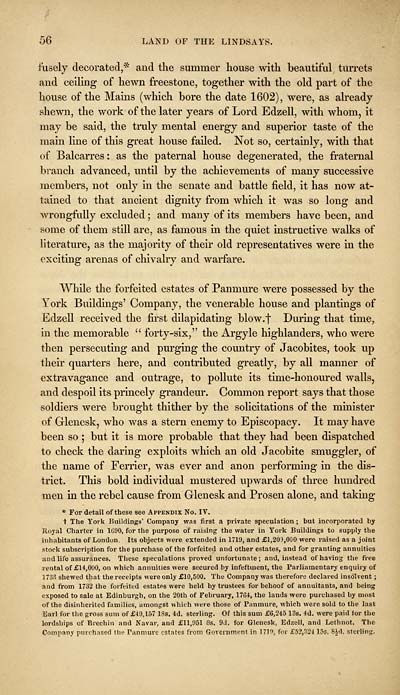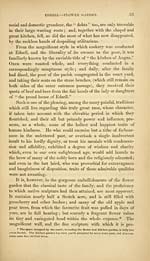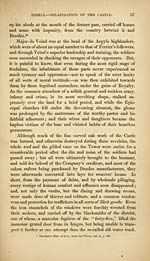Download files
Complete book:
Individual page:
Thumbnail gallery: Grid view | List view

56 LAND OF THE LINDSAYS.
fusely decorated,* and the summer house with beautiful turrets
and ceiling of hewn freestone, together with the old part of the
house of the Mains (which bore the date 1602), were, as already
shewn, the work of the later years of Lord Edzell, with whom, it
may be said, the truly mental energy and superior taste of the
main line of this great house failed. Not so, certainly, with that
of Balcarres: as the paternal house degenerated, the fraternal
branch advanced, until by the achievements of many successive
members, not only in the senate and battle field, it has now at-
tained to that ancient dignity from which it was so long and
wrongfully excluded ; and many of its members have been, and
some of them still are, as famous in the quiet instructive walks of
literature, as the majority of their old representatives were in the
exciting arenas of chivalry and warfare.
While the forfeited estates of Panmure were possessed by the
York Buildings' Company, the venerable house and plantings of
Edzell received the first dilapidating blow.f During that time,
in the memorable " forty-six," the Argyle highlanders, who were
then persecuting and purging the country of Jacobites, took up
their quarters here, and contributed greatly, by all manner of
extravagance and outrage, to pollute its time-honoured walls,
and despoil its princely grandeur. Common report says that those
soldiers were brought thither by the solicitations of the minister
of Glenesk, who was a stern enemy to Episcopacy. It may have
been so ; but it is more probable that they had been dispatched
to check the daring exploits which an old Jacobite smuggler, of
the name of Ferrier, was ever and anon performing in the dis-
trict. This bold individual mustered upwards of three hundred
men in the rebel cause from Glenesk and Prosen alone, and taking
* For detail of these see Appendix No. IV.
i The York Buildings' Company was first a private speculation ; but incorporated by
Royal Charter in 1C90, for the purpose of raising the water in York Buildings to supply the
inhabitants of London. Its objects were extended in 1719, and £1,203,000 were raised as a joint
stock subscription for the purchase of the forfeited and other estates, and for granting annuities
and lifo assurances. These speculations proved unfortunate; and, instead of having the free
rental of £14,000, on which annuities were secured by infeftuient, the Parliamentary enquiry of
1733 shewed that the receipts were only £10,500. The Company was therefore declared insolvent ;
and from 1732 the forfeited estates were held by trustees for behoof of annuitants, and being
exposed to sale at Edinburgh, on the 20th of February, 1764, the lands were purchased by most
of the disinherited families, amongst which were those of Panmure, which were sold to the last
Earl for the gross sum of £49,157 ISs. 4d. sterling. Of this sum £6,245 13s. 4d. were paid ior the
lordships of Brechin and Navar, and £11,951 8s. 9J. for Glenesk, Edzell, and Lethnot. The
Company purchased the Panmure estates from Government in 17in, for £52,324 15s. Sid, sterling.
fusely decorated,* and the summer house with beautiful turrets
and ceiling of hewn freestone, together with the old part of the
house of the Mains (which bore the date 1602), were, as already
shewn, the work of the later years of Lord Edzell, with whom, it
may be said, the truly mental energy and superior taste of the
main line of this great house failed. Not so, certainly, with that
of Balcarres: as the paternal house degenerated, the fraternal
branch advanced, until by the achievements of many successive
members, not only in the senate and battle field, it has now at-
tained to that ancient dignity from which it was so long and
wrongfully excluded ; and many of its members have been, and
some of them still are, as famous in the quiet instructive walks of
literature, as the majority of their old representatives were in the
exciting arenas of chivalry and warfare.
While the forfeited estates of Panmure were possessed by the
York Buildings' Company, the venerable house and plantings of
Edzell received the first dilapidating blow.f During that time,
in the memorable " forty-six," the Argyle highlanders, who were
then persecuting and purging the country of Jacobites, took up
their quarters here, and contributed greatly, by all manner of
extravagance and outrage, to pollute its time-honoured walls,
and despoil its princely grandeur. Common report says that those
soldiers were brought thither by the solicitations of the minister
of Glenesk, who was a stern enemy to Episcopacy. It may have
been so ; but it is more probable that they had been dispatched
to check the daring exploits which an old Jacobite smuggler, of
the name of Ferrier, was ever and anon performing in the dis-
trict. This bold individual mustered upwards of three hundred
men in the rebel cause from Glenesk and Prosen alone, and taking
* For detail of these see Appendix No. IV.
i The York Buildings' Company was first a private speculation ; but incorporated by
Royal Charter in 1C90, for the purpose of raising the water in York Buildings to supply the
inhabitants of London. Its objects were extended in 1719, and £1,203,000 were raised as a joint
stock subscription for the purchase of the forfeited and other estates, and for granting annuities
and lifo assurances. These speculations proved unfortunate; and, instead of having the free
rental of £14,000, on which annuities were secured by infeftuient, the Parliamentary enquiry of
1733 shewed that the receipts were only £10,500. The Company was therefore declared insolvent ;
and from 1732 the forfeited estates were held by trustees for behoof of annuitants, and being
exposed to sale at Edinburgh, on the 20th of February, 1764, the lands were purchased by most
of the disinherited families, amongst which were those of Panmure, which were sold to the last
Earl for the gross sum of £49,157 ISs. 4d. sterling. Of this sum £6,245 13s. 4d. were paid ior the
lordships of Brechin and Navar, and £11,951 8s. 9J. for Glenesk, Edzell, and Lethnot. The
Company purchased the Panmure estates from Government in 17in, for £52,324 15s. Sid, sterling.
Set display mode to:
![]() Universal Viewer |
Universal Viewer | ![]() Mirador |
Large image | Transcription
Mirador |
Large image | Transcription
Images and transcriptions on this page, including medium image downloads, may be used under the Creative Commons Attribution 4.0 International Licence unless otherwise stated. ![]()
| Histories of Scottish families > History and traditions of the land of the Lindsays in Angus and Mearns > (74) Page 56 |
|---|
| Permanent URL | https://digital.nls.uk/94869914 |
|---|
| Description | A selection of almost 400 printed items relating to the history of Scottish families, mostly dating from the 19th and early 20th centuries. Includes memoirs, genealogies and clan histories, with a few produced by emigrant families. The earliest family history goes back to AD 916. |
|---|

